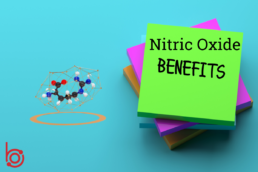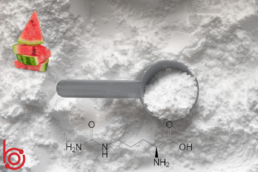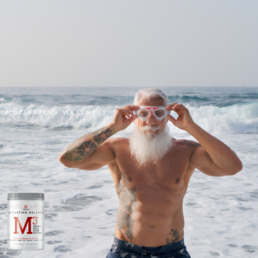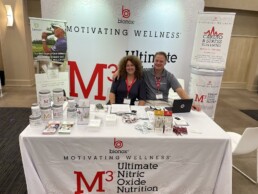Nose Breathing: A Nitric Oxide Boosting Hack
Breathing is something we all do with little to no thought involved. We do not have to remind ourselves to breathe; we just do it. For most of our day-to-day lives, breathing requires no conscious effort. Be that as it may, paying attention to how you breathe is still important. This means paying attention to which method of breathing you use more: nose breathing or mouth breathing.
It is better for you to breathe through your nose rather than your mouth. Nose breathing is more natural and allows air inhaled to be used more efficiently. Even with this information easily accessible thanks to the internet, as many as half of all adults breathe through their mouths. This tendency to prefer mouth breathing leads to problems such as bad breath, dry mouth, and sub-optimal air utilization. Furthermore, mouth breathing can lead to sleeping problems. If you are at all concerned about your health, you know quality sleep is essential.
If you notice you favor mouth breathing over nose breathing, it might be time to go see your doctor and get to the root of the problem. By learning about and eliminating the cause of mouth breathing, you can learn to focus on nose breathing and reap those benefits.
How do nose breathing and mouth breathing differ?
As humans, we only have two methods for breathing available to us. The nose and the mouth are how we breathe. Both are connected to the throat, which is connected to our lungs. Even though both pathways lead to the same destination, there are still differences. Like with any fork in the road, the journey will look a little different depending on the path you take. Let’s explore more of what differences there are between nose breathing and mouth breathing.
What is mouth breathing?
The mouth is a very multi-functional tool. We use it to eat, drink, talk, spit, cough, whistle, and so much more. While we can use our mouths to breathe, it is not as optimized for breathing as the nose is. Mouth breathing does have its purpose, but usually due to some obstruction in the nasal pathway. Some reasons mouth breathing would be necessary include:
- nasal congestion
- deviated septum
Even if you have a good reason for breathing through your mouth, there are health risks involved. As you breathe through your mouth, your mouth becomes dry. This dry mouth can increase your risk of developing:
- asthma
- bad breath
- tooth decay
- dental issues such as gingivitis
- sleeping disorders
- poor concentration
- teeth and jaw abnormalities
Mouth breathing has its place but should be used sparingly and only when necessary.
What is nose breathing?
The nose is specifically designed for breathing, so has many advantages over mouth breathing. Nose breathing can do things such as:
- filter foreign substances
- humidify inhaled air
- increase oxygen uptake
- improve lung capacity
- slow down breathing
- strengthen the diaphragm
These benefits are not all the benefits you can acquire through nose breathing but does serve to give you a general idea of nose breathing benefits.
How is nose breathing better than mouth breathing?
The nose is designed to improve the quality of air we inhale. The nose helps us breathe safely and efficiently. Our noses have a few key attributes that make them superior for breathing when compared to the mouth. Let’s take a look at some of these advantages the nose has over the mouth.
Humidifies inhaled air.
When we breathe in through our noses, the nose warms and moisturizes the air. This makes sure the air we take into our lungs is body temperature. This in turn makes the air easier for the lungs to use.
Filters out unwanted particles.
Our nose hairs act as a built-in filter. These hairs trap pollen, dust, allergens, and other unwanted particles and keep them from entering the lungs. Nose hairs can do this because they are coated with a thin layer of sticky mucus. Over time, you will sneeze out or swallow what was trapped in the nose. The nose also has cilia in it, which are microscopic hairs that keep particles away from the lungs.
Produces nitric oxide (NO).
This is the benefit I wanted to highlight. Nose breathing can help promote the production of nitric oxide in our bodies. During nasal breathing, the nose will release nitric oxide. Another benefit of breathing through the nose is that doing so allows us to breathe in slowly and deeply. This allows for more oxygen to be taken in deliberately when compared to the big gulps of the air we intake when we breathe through the mouth. Since we take in more air when we nose breathe, we increase the nitric oxide production potential when we nose breathe.
Nitric oxide is a vasodilator, which means it widens blood vessels when produced. Nose breathing allows more oxygen to be inhaled, and nitric oxide widens blood vessels. Put these together, and you have a recipe for promoting improved oxygen delivery and utilization throughout the body. Furthermore, nose breathing is something you can do today to improve your nitric oxide production without needing to add anything to your daily life like a new food or a new supplement.
How do we stop mouth breathing?
Remember, mouth breathing does have some benefits. Mouth breathing can be necessary when the nose is congested or injured. We also need to breathe through our mouths more when we are sick. Mouth breathing can also come in handy during strenuous work when our muscles need rapid bursts of oxygen. Nose breathing is more difficult during exercise, so mouth breathing is used to increase ventilation volume for increased oxygen levels.
However, mouth breathing is still inferior overall to nose breathing and there are multiple ways to decrease your mouth breathing. To promote more nasal breathing, figuring out why you mouth breathe is the necessary first step. For some, a visit to a sleep or breathing specialist might be needed. However, you can go through the following list of suspects and try to eliminate these common issues to improve your nose breathing.
Clear your nostrils.
This one is going to be helpful to the vast majority of readers. Obstructed airways are a major cause of mouth breathing. Cleaning out your nasal passages can help make nose breathing easier. Nasal irrigation via a neti pot is great for cleaning out the nasal passageways. A neti pot will flush out any trapped particles, thin out some mucus, and relieve congestion. All of these will make nose breathing easier. Neti pots are also useful for relieving symptoms of sinus infections, colds, and other illnesses associated with congestion.
Some other remedies for obstructed nostrils are eucalyptus oil and vapor rub. Both will help open up your airways and loosen up mucus. Rubbing vapor rub on your chest and/or adding eucalyptus oil to steaming water and breathing it in will both improve nasal breathing capacity.
Practice nose breathing.
If mouth breathing is more of a habit than a necessity, you just need to practice nose breathing to break that habit. You do this by being more mindful of your breathing patterns throughout the day.
Pay attention to how you are breathing. If you notice you are mouth breathing, redirect your breathing on the spot. Some nasal breathing exercises can also help improve nose breathing, and we will talk more about that soon.
Change how you sleep.
Some sleeping positions are better than others. Because of this, changing your sleeping position can improve both how you sleep and how you breathe. For many, the big culprit is sleeping on your back.
Sleeping on your back can cause mouth breathing because it causes upper airway resistance. This forces you to take heavier breaths. When you stop sleeping on your back, you can also reduce sleep apnea.
If you need to change your sleeping position, look into elevating your head above the rest of your body, or sleeping on your side with a pillow between your legs to maintain a neutral spine. If you have the money to spare, an adjustable mattress would be a great investment as well. All of these sleep changes can make nose breathing easier.
How do we improve nose breathing?
If you have implemented the tactics above to decrease mouth breathing, you can still improve nose breathing using a variety of nose breathing exercises. Breathing exercises can improve not only your nose breathing but also your lung function and respiratory strength. Furthermore breathing exercises can reduce stress and anxiety. This requires practice and will take some time to feel natural, but if you stick to it you can vastly improve your nose breathing.
Let’s check out a couple of common breathing exercises you can start practicing even while you read this article.
Timed breathing.
This one is fantastic for slowing down your breathing and focuses on the proper technique of inhaling through the nose and exhaling through the mouth. Here is how it works:
- Inhale for 7 seconds through your nose at a steady pace.
- Hold your breath for 3 seconds.
- Exhale through your mouth for 4 seconds.
You can add time or decrease times spent inhaling, holding your breath, or exhaling as needed based on your current capacity. This exercise not only improves nose breathing but also works to improve your lung capacity as a whole. This exercise is my personal favorite because you can progress or scale the exercise as needed to start at a level suited for your capabilities and track improvements over time.
Belly breathing.
Abdominal breathing and diaphragmatic breathing are other terms for belly breathing. This involves taking slow and deep breaths through your nose. This exercise, like most breathing exercises, can be performed anywhere at any time. You can do this one lying down or seated, so get comfortable and give it a go. Here’s how to do it:
- Close your mouth. Put one hand on your belly and one on your chest.
- Breathe in slowly through your nose, letting the belly expand. Your chest should not move at all.
- Exhale slowly through the mouth and repeat.
The Takeaway
What you need to know is that nose breathing is better for you than mouth breathing. Nose breathing is healthier, safer, and more efficient for your body. Breathing through your nose can filter out unwanted particles, can boost your nitric oxide production, boost oxygen uptake, and humidity the air you breathe. Practice the techniques above and implement this little-known nitric oxide boosting hack today!
Can You Take Nitric Oxide Every Day?
Your nitric oxide (NO) levels are a determining factor for health you should not ignore. Nitric oxide is a neurotransmitting molecule that the body produces in various ways. However, NO is used just as rapidly as it is produced. So the answer to the question, “can you take nitric oxide every day?” is a loaded question. Yes, you certainly can, and probably should depending on a multitude of factors. We will explore why you should take nitric oxide each day. We will also explore the best times to boost NO production to optimize your well-being. So while the answer is yes, I implore you to read on to learn why you can and should take NO every day.
What is nitric oxide?
Nitric oxide is a molecule produced by almost every cell in the body. Common precursors used by the body to create nitric oxide are the amino acids L-citrulline and L-arginine, and nitrates. Nitric oxide is one of the most important molecules for our health. This is due to NO being a vasodilator, responsible for widening the blood vessels. This benefit allows for many of the other health benefits nitric oxide offers to take effect. NO has a hand in cognitive function, sexual health, heart health, muscle growth, and more. The accolades bestowed upon nitric oxide are well-deserved.
When should you take nitric oxide?
NO can be boosted in many ways. Exercise, exposure to sunlight, and nasal breathing are all helpful in promoting NO production. While there is hardly ever a bad time to boost your NO levels, some instances would be a higher priority over others. Some of these include:
- Before exercising
- After exercising
- Any point when you need an energy boost
- When experiencing high blood pressure
- When experiencing certain heart problems
- When recovery is needed rapidly
This list is not the end-all-be-all of circumstances where boosting NO would be beneficial, but it’s a good starting point. For many people, it will depend on what kind of individual you are. Are you an average joe? Are you an athlete? Perhaps you’re someone trying to combat hypertension? We will look at specific populations of people and determine when the best time to take nitric oxide is for them.
When should you take nitric oxide if you want to improve athletic performance?
For athletes or anyone looking to enhance their performance, boosting your NO with something like beetroot juice will improve your endurance and stamina. This will help you push through more intense workouts for longer. This will also improve strength training efforts and help out with muscle recovery after the workout. These benefits occur because NO helps make blood flow more efficient. This in turn allows more oxygen and nutrients to be delivered to the muscles.
If you want to boost your NO levels before a workout, the timetable will look different depending on your method. If you want to drink beetroot juice, you want to drink up around 2-3 hours before the workout to maximize the benefits. However, if you’re going to use a more natural supplement like eating specific fruits and vegetables, you should do so within 90 minutes of your workout.
Furthermore, increasing your NO consumption overall will improve your endurance over time. So if you are a cyclist, runner, or swimmer, chances are you will reap the most benefits from the endurance-enhancement NO consumption provides.
When should you take nitric oxide to reduce muscle soreness?
It’s pretty normal to feel sore and fatigued after a grueling workout session. This is just a normal response to inflammation in the muscles. The body is working to repair itself from the tearing of muscle fibers that occurs when you work out. To repair itself, the body sends blood, oxygen, and nutrients to the muscles so they can replenish their levels and recover the energy expended.
When should you take nitric oxide to boost energy?
Make no mistake, plenty of other factors influence your energy levels. A balanced diet and 7-8 hours of quality sleep are the most important things you can look at for enhancing your energy. If you have already optimized these factors, then you can see what NO has to offer for energy.
NO levels fluctuate based on the 24-hour light/dark cycle. Because of this, humans have adapted to this cycle with the help of neuromodulators. These neuromodulators are messengers released from a neuron that affects the transmission of the signals between neurons. Neuromodulators essentially respond to variation in the environment by sending signals between neurons. NO happens to be a neuromodulator tasked with helping our cells optimize energy usage based on the light cycle.
Nitric oxide levels are lowest first thing in the morning, so this is the best time to take a booster. Consuming NO boosters in the morning can improve energy levels throughout the day, and can help improve your circadian clock. This makes sleeping easier.
Other reasons to take nitric oxide
Nitric oxide has been linked to other benefits such as stress relief, lowering blood pressure, easing anxiety, and improving overall health. Let’s take a look at some of these other benefits and see when the best time to take NO is for them.
Stress relief
NO boosting activities can be used to reduce stress. This requires you to do more than just drink a juice or take a capsule. This requires you to engage in exercises such as nose breathing. This works because nose breathing stimulates the vagus nerve. The vagus nerve is responsible for activating your parasympathetic nervous system, which is responsible for making you calm and restful. As the parasympathetic nervous system is activated, your stress levels will drop. As a bonus, nose breathing boosts NO production via paranasal sinuses as you inhale.
How do we do this? Listed below are two common nose breathing practices you can use to reduce stress.
- Timed Breathing. For this, start by inhaling through your nose for seven seconds at a steady pace. Hold your breath for about three seconds, and exhale through your mouth for four seconds. Repeat this for a few minutes. This exercise will boost your nitric oxide as well as relieve stress by slowing down your breathing rate.
- Belly Breathing. For this, start by placing one hand on your belly and one hand on your chest. Breathe in deeply through your nose into your belly until it cannot expand anymore. Then exhale through your mouth. Your chest should not move during this exercise.
Both of these exercises encourage nose breathing, so will boost your NO levels as well as ease your stress if you do them for a few minutes each day.
Anxiety symptom relief
As some of you might know, anxiety is a broad term with many symptoms associated with it. Some that are prevalent include elevated heart rate, rapid breathing, and overall feelings of stress and tension. Similar to the stress exercises above, nose breathing exercises can minimize some of these anxiety symptoms. Here are a couple of things you can do that will boost your nitric oxide levels and ease your anxiety symptoms:
- Each day, set aside a few minutes each morning to practice deep breathing (inhaling through the nose and exhaling through the mouth). This engages the parasympathetic nervous system and boosts NO levels. You can use the exercises above or Google a few other options as well.
- Walk around outside for roughly 20 minutes. Exposure to sunlight helps to boost our body’s ability to produce nitric oxide. Furthermore, exposure to sunlight increases vitamin D production and releases serotonin. Serotonin is a neurotransmitter that affects mood and other processes. Low serotonin levels have been linked to increased anxiety.
As a note, do not forget that quality sleep, a balanced diet, and exercise can also have a positive impact on both stress and anxiety.
Improving overall health
To improve your overall health, you can maximize your NO levels. You can do this by adding in activities and supplements throughout the day that can optimize your nitric oxide and provide you with consistent levels throughout the day. Consistent NO levels will maximize all the benefits NO provides our bodies. Below will be the best times of the day to engage in NO boosting and how you can do it.
First thing in the morning
- nose breathing exercises
- exercise
- NO booster supplement
Midday/Afternoon
- Sunlight exposure
- exercise
- NO boosting lunch (leafy greens, beets, fruits, etc.)
- NO boosting supplement
Evening
- NO rich dinner
- nose breathing exercises
- NO boosting supplement before bed
The Takeaway
With so many nitric oxide boosters and activities at our disposal, it is easier than ever to reach and maintain optimal NO levels. To keep those levels high, daily boosting is encouraged. How you do so will be individually goal-based. You engage in the boosters and activities that you will enjoy and stick to consistently. So with all the benefits we know nitric oxide provides, we can definitely say you can take nitric oxide every day.
Improving Nitric Oxide Production and Heart Health
Few people know about nitric oxide (NO) and all the health benefits associated with it. What cannot be stated enough is that we need this little compound to thrive at our best. Nitric oxide production plays a critical role in promoting heart health. Nitric oxide works to make our blood vessels wider and more flexible. A benefit of this is improving our blood flow. This blood flow is the start of so many other wonderful benefits associated with nitric oxide production, such as circulation improvement. Failure to build sufficient amounts of nitric oxide in the body can lead to heart disease after enough time.
What Is Nitric Oxide?
A common nickname for nitric oxide is the “miracle molecule.” Nitric oxide is held in such high regard because it plays a crucial role in so many cellular processes and body processes. Some of these processes include digestion, memory, immune response, and circulation. Furthermore, nitric oxide production is so important because nitric oxide is a signaling neurotransmitter. NO is used to communicate across almost every cell in the body. How does this relate to heart health? Nitric oxide production helps protect our cardiovascular systems from aging and the damage that can occur from lifestyle choices. NO helps our heart and blood vessels stay healthy and functional.
Why Nitric Oxide Production Matters For Heart Health
The main function of nitric oxide on heart health is arterial elasticity; this is a fancy way of saying NO helps our blood vessels stay flexible as we age so that blood flow can remain optimal. NO can help ensure your red blood cells do not stick together and start to form clots and blockages. NO also supports a healthy blood pressure level. The endothelial lining of your arterial walls produce nitric oxide naturally. As long as this lining stays healthy, you won’t be vulnerable to inflammation and other damaging side effects of decreased nitric oxide production.
Unfortunately, nitric oxide levels begin to drop as we get older. As a result, the older you get, the more important it is to boost your nitric oxide levels. With all this in mind, you may be wondering what you can do to optimize your nitric oxide levels to avoid any unwanted heart problems?
How To Boost Your Nitric Oxide Levels For Your Heart Health
There are several ways you can ensure you have optimal nitric oxide levels for your heart health. Here are a few tips to boost nitric oxide levels:
1. Take L-arginine
L-arginine is an amino acid used as a primary precursor for nitric oxide production. This amino acid can be found in foods such as red meat, chicken, salmon, legumes, almonds, and cheese. L-arginine is also widely available as a supplement if you have food preferences or dietary restrictions that limit the exposure you can get to L-arginine through food.
2. Eat Nitrate-Dense Foods
Certain vegetables contain a compound called nitrates. Nitric oxide production is possible through converting nitrates. Eating foods rich in nitrates will boost and optimize your nitric oxide production. Some foods high in nitrates include:
- Spinach
- Arugula
- Beetroot
- Celery
- Lettuce
- Kale
- Chard
- Radishes
- Turnips
This list is definitely not all the vegetables out there, but it’s a good start for you to begin adding nitrates into your nutrition. Eating foods that are nitrate dense can lower blood pressure as well as improve energy and stamina levels in some people.
It is worth pointing out that the nitrates found in vegetables are okay for large consumption. Processed meats such as bacon and hot dogs commonly contain nitrates. Those nitrates are used as a preservative and have been linked to some cancers. However, the nitrates from your vegetables are safe and contain antioxidants such as vitamin C. So eat your veggies, but try to avoid excessive bacon consumption. Your nitric oxide production will be boosted for sure if you do this.
3. Consume More Antioxidants
The body naturally produces nitric oxide but uses it up quickly. Because of this, it needs to be consistently replenished to keep levels high and experience the heart health benefits. One way we can do this is by introducing more antioxidants into our diets. Antioxidants are molecules that rid the body of excess free radicals that create oxidative stress. These free radicals can break down nitric oxide molecules rapidly, so we want antioxidants to stop this.
Some foods commonly associated as antioxidant-rich are:
- Dark chocolate
- Pecans
- Blueberries
- Raspberries
- Strawberries
- Kale
- Beets
- Spinach
Types of Antioxidants
Various other fruits, nuts, seeds, and vegetables aside from the ones listed above contain antioxidants as well. Some of the most common types of antioxidants are:
- Vitamin C: Vitamin C forms connective tissues as well as produces brain chemicals to aid in nerve cell communication and signaling.
- Vitamin E: Vitamin E shields from free radicals which can negatively impact aging and speed up the onset of some diseases. It also helps keep the immune system strong.
- Polyphenols: The body uses polyphenols to fight off the risk of cancers and cardiovascular disease.
- Glutathione: The body uses glutathione as a detoxifier for cells. Glutathione is known as “the mother of all antioxidants” because it is present in almost every cell in the body. It also plays a role in various body systems and functions.
Some research supports the idea that taking nitric oxide precursors such as nitrates with antioxidants can optimize nitric oxide levels by slowing down the rate of nitric oxide breakdown. Also, most vegetables that are high in nitrates are full of antioxidants. This combination allows for improved nitric oxide production and optimal consistent levels. This consistently high level of nitric oxide is what is needed to promote heart health benefits.
4. Exercise
The whole point of exercising is to get the blood pumping right? Well, your nitric oxide production increases when you exercise. Exercise promotes blood flow, which promotes the delivery of oxygen and nutrients. Not to mention the cardiovascular benefits of working your muscles, heart, and lungs consistently. Blood pressure levels and improved endothelial health can result from more exercise.
Protecting the Endothelium
The endothelium is the cellular lining within blood vessels. These are the cells that produce nitric oxide. When they produce nitric oxide, the blood vessels stay flexible and dilated for improved blood circulation throughout the body. If nitric oxide levels become insufficient, your endothelium can become dysfunctional. This dysfunction leads to heart problems and blood pressure issues like hypertension.
When we exercise, we promote endothelium health by increasing vasodilation. Vasodilation is the widening of blood vessels via relaxation of the smooth muscles within the lining of arteries. By incorporating more aerobic exercise such as jogging and walking into your daily routine, you can improve your endothelial health and increase nitric oxide production.
5. Use Nitric Oxide Boosting Supplements
This one is an obvious choice if you can check the other boxes above. You should always try to get nitric oxide boosters from lifestyle choices and nutrition first. If you find that all of the above still isn’t enough, then it’s time to look into supplements. Nitric oxide supplements do not contain nitric oxide, but they do contain the precursors the body can use to convert into nitric oxide. The most common ingredients you will find are L-arginine and L-citrulline.
Both of these are amino acids. L-arginine promotes nitric oxide via the L-arginine-NO pathway. The body naturally produces L-citrulline. As a result of this natural production, L-citrulline gets converted into L-arginine. This allows for more L-arginine available for nitric oxide production. Both amino acids are great for decreasing blood pressure, so are both great for heart health. These amino acids are usually split into some ratio in a NO booster. The ideal ratio of L-arginine to L-citrulline is 2:1.
The Takeaway
Nitric oxide is essential for overall heart health. As vasodilation occurs, blood flow becomes more efficient. This allows more oxygen and nutrients to be available for cells and muscles. Because of this, it is important to achieve and sustain optimal nitric oxide levels.
Nitric oxide is a valuable tool to have in your health arsenal. Almost every cell in your body utilizes it. Your muscles use it for energy, stamina, and fatigue control. The brain uses it to communicate between neurons. Your blood cells use it to avoid clotting. The reproductive organs use it to increase libido and sexual health. Our immune system uses it to stay strong and vigilant against foreign intruders.
Nitric oxide is easy to add to your diet in various forms. There is no shortage of benefits to your body as a whole when supplementing nitric oxide. As a bonus, when we increase our nitric oxide consumption, our bodies begin to produce more nitric oxide naturally. If you care about living a long life with a strong heart, seriously look into what nitric oxide can do for you. If you are on any medication, talk to your doctor. Otherwise, follow the steps above and enhance your nitric oxide production asap!
10 Nitric Oxide Benefits You Need To Know
What is Nitric Oxide?
Nitric oxide is a signaling molecule that is produced by almost every cell in the body. Nitric oxide is also a neurotransmitter, working as a signaling molecule that plays a vital role in multiple processes throughout the body. Some of these processes include digestion, blood flow, vision, memory, immune system function, recovery, etc. Nitric oxide works by relaxing and widening the blood vessels. As this happens, hormones such as growth hormone (GH) and insulin are released. Furthermore, this widening of the blood vessels is the precursor to the majority of nitric oxide benefits. This process is referred to as vasodilation.
What is vasodilation?
Vasodilation is the relaxing and widening of blood vessels. The smooth muscles in the arterial walls relax, which allows the blood vessels to widen. As a result, blood flow improves and blood pressure lowers.
How do we make nitric oxide?
Nitric oxide is not something we produce on its own. Nitric oxide needs precursors to be produced. Primarily, these precursors are L-arginine and L-citrulline. L-citrulline will be used to produce more L-arginine and L-arginine is used to synthesize nitric oxide. Once nitric oxide is produced, we can enjoy the various health benefits. Due to all the nitric oxide benefits we can potentially experience, it is often referred to as the “miracle molecule.”
Without further ado, here is a list of 10 nitric oxide benefits.
Nitric Oxide Benefits
1. Can Help Control Type 2 Diabetes
It may be a little known fact, but there is evidence showing that nitric oxide production is impaired in those suffering from type 2 diabetes. As a result of this impairment, potential problems include high blood pressure, kidney issues, heart problems, and more. Because nitric oxide is so critical for so many body and cellular processes, supplementing nitric oxide or getting more nitric oxide through diet and lifestyle choices is essential for fighting diabetes symptoms. Some of the nitric oxide benefits pertaining to diabetes include improved blood circulation, improved oxygen and nutrient delivery, improved wound healing, increased insulin sensitivity, and improved blood sugar control. The precursor of nitric oxide, L-arginine, has been suggested to be able to delay the onset of diabetes, but more research is needed before L-arginine can be looked at as a prescription for diabetics.
2. Circulation
Honestly, this nitric oxide benefit should have been first on the list. Improved blood circulation is responsible for many of the other benefits associated with nitric oxide. Since nitric oxide causes the blood vessels to widen, it makes sense that your blood circulation would improve since more blood is now flowing through the wider vessels. As blood circulation increases, nutrient and oxygen delivery improve as well. As another benefit of improved circulation, you may experience improved cardiovascular health but we will touch more on that later.
3. Sexual Health In Men
Fellas, this ones for you. If you have any issues getting your flagpole to full mass, nitric oxide may be able to help. Another nitric oxide benefit is its potential to help men suffering from erectile dysfunction (ED). Because nitric oxide improves blood flow throughout the body, it is possible that as blood delivers oxygen and nutrients more efficiently, you can experience a decrease in ED symptoms. Furthermore, nitric oxide is necessary for the penis to become erect. Contrary to what you would think, muscles around the penis have to relax in order to allow blood to flow in and give you an erection. Nitric oxide is good at relaxing smooth muscles in arterial walls. This in turn allows blood to flow in and can increase the frequency and duration of erections in men suffering from ED.
4. Blood Pressure
We kind of already touched on this nitric oxide benefit. However, in case you missed it, we can highlight the benefit here. As vasodilation allows more blood to flow through blood vessels, this decreases blood pressure. High blood pressure occurs when the force of your blood against the vessel walls is too high. Over time, high blood pressure can lead to issues such as kidney and heart disease. We want to avoid high blood pressure, so if you have hypertension or heart issues now, supplementing nitric oxide boosters may be beneficial for you in the long run.
5. Exercise Performance
This nitric oxide benefit could really help the gym bros and chicks out there. Since nitric oxide is so critical to so many processes within the body, some of those processes affect exercise performance. One of those is blood circulation. As blood circulation allows improved nutrient and oxygen delivery, muscles get more necessary fuel during and after a workout. It is because of this that many pre-workouts on the market include nitric oxide precursors such as L-citrulline and L-arginine. The takeaway here is that supplementing nitric oxide can potentially improve your energy and stamina while you work out. This will allow you to work out longer and harder, as well as recover faster.
6. Immune System Support
If you are prone to getting sick more than others around you, this nitric oxide benefit is for you. In light of the recent pandemic and the threat of future pandemics, immune system health has been a focal point for many the past few years. We all want to give our immune systems the best chance of fighting out illness. Yes, we can get vaccinated, quarantine, and all these other reactive measures. However, we can also implement some preventative measures as well.
These include a healthy diet, staying in good shape, getting quality sleep, etc. If you are already doing these, the next thing you can do is add some nitric oxide to your diet. Research suggests increasing your NO levels can improve immune system function. This is because NO is used by immune system cells to fight tumors, infections, and foreign intruders. It also sends signals throughout the body, making it crucial for getting cells prepared to fight off infections and diseases.
7. Cardiovascular and Heart Health
The nitric oxide benefits for your ticker are well worth mentioning. Due to NO’s ability to kickstart vasodilation, blood pressure gets lowered. When this happens, arterial stiffness decreases and so does the risk of heart disease. Also, improved blood flow allows the heart to pump blood more efficiently, helping the heart stay strong and healthy thanks to the optimal oxygen and nutrient delivery.
8. Wound Healing
This nitric oxide benefit is a little nuanced because other factors are at play when it comes to your ability to heal from a wound. However, it is hypothesized that because NO is a signaling molecule and is a key component of immune system function it has a role in wound healing. NO is likely partially responsible for skin rebuilding after an injury since it would signal immune system cells and repair cells to do their jobs. More research is needed to determine the extent of the role nitric oxide plays in wound healing.
9. Reproduction Health
This nitric oxide benefit applies to men and women. For women, nitric oxide plays a role in menstrual regulation, pregnancy progression, and fetal development from embryo to newborn during the duration of the pregnancy term. There is research suggesting potential fetal development can be impaired if there are insufficient NO levels in the mother’s body.
For men, NO helps regulate sperm development, sperm motility, sperm strength (ability to penetrate an egg), and sperm maturity. Insufficient NO levels can lead to low sperm count and low sperm vitality. Also, since nitric oxide helps with ED, nitric oxide helps sperm get delivered via improved erections.
10. Brain Health
If you or your family have a history of neurodegenerative disorders, this will likely pertain to you. Turns out that supplementing nitric oxide can improve blood flow to the brain. Furthermore, since nitric oxide is a signaling neurotransmitter, it plays an important role in intracellular communication between neurons in the brain. Because of the role NO plays in neuron communications, NO can potentially aid in the treatment of diseases like dementia and Alzheimer’s.
Other Reported Nitric Oxide Benefits
There are already plenty of reasons to look into increasing NO consumption. However, people often take NO supplements for reasons other than well-researched benefits. Some possible benefits which are strictly anecdotal are:
improved lung function for those with lung-debilitating illnesses
preventing COVID-19
improving memory loss
preventing common colds
treating altitude sickness
speeding up weight loss
healing foot ulcers
speeding up recovery after a major injury
speeding up recovery after a major trauma
Other Nitric Oxide Benefits
Many of the benefits have some scientific research backing them up, but not enough to be a routine prescription from doctors. Most of the time, you can easily add more nitric oxide into your life by:
eating foods high in nitrate
eating foods high in antioxidants
increasing sunlight exposure
decreasing stress
nose breathing
limiting mouthwash use
exercise
The Takeaway
This list is far from exhaustive, but it’s a good start for increasing NO levels. There are very few side effects for you to worry about, so NO is safe for most people to consume. If you have any blood pressure or heart medications, certainly ask your doctor for advice before trying to actively increase your nitric oxide levels. Always ensure you are safe before adding anything to your health regimen. Nitric oxide plays a role in so many processes related to human health. If it makes sense for you to add more in or supplement with an NO booster, do so.
L-Citrulline: Everything You Need To know
What if I told you there is a supplement out there in the vast wild west known as the health industry that can improve cognitive health, improve exercise performance, improve blood flow, and more? Would you be interested in learning about this supplement? If so, you’ve come to the right place. L-citrulline has been gaining popularity in fitness circles recently for its possible benefit of improving exercise performance. If you’re reading this, chances are you care about more than your post-workout pump. L-citrulline has a host of other potential benefits as well as risks. We will explore the ins and outs of L-citrulline so you have all the facts. Let’s go over everything you could ever need to know about this supplement and see if it’s worth adding to your health and wellness protocols.
What Is L-Citrulline?
L-citrulline is an amino acid that occurs naturally in the body. Foods such as watermelon and pumpkin seeds contain high levels of L-citrulline. Since the body produces L-citrulline naturally, we call it a nonessential amino acid. Even though L-citrulline is an amino acid, it does not directly impact protein synthesis. However, it still has value in other processes within the body. L-citrulline could also potentially increase chemicals in the body that aid in protein synthesis. One such chemical process L-citrulline is a vital component of is the urea cycle. This cycle is responsible for flushing harmful compounds such as ammonia from the body. Urine flushes out the urea that remains. So now you know what L-citrulline is, let’s look at how it works.
How Does L-Citrulline Work?
We know that L-citrulline is an amino acid produced in the body and used for various body processes. One of those processes is vasodilation. Vasodilation is the relaxing and widening of blood vessels. This process is made possible via the conversion of L-citrulline into another amino acid, L-arginine. When this happens, L-arginine gets converted into nitric oxide. This in turn promotes vasodilation thanks to the relaxing of cells within the blood vessels. A popular question amongst nutrition experts is: “why should we supplement L-citrulline for vasodilation when it’s converted into L-arginine anyway?” Why not just supplement L-arginine?
This is a fair question, and maybe one you are asking as well. What researchers found is the body seems to better absorb L-citrulline, or at least differences in absorption rate demonstrate consuming L-citrulline may increase the bioavailability of L-arginine better than consuming L-arginine itself. We have already touched on a couple benefits of L-citrulline, but let’s dive a little deeper now.
What are the benefits of L-Citrulline?
L-citrulline has had research conducted to look into the potential benefits for various areas of health. This includes cognition, sexual health, exercise performance, fatigue recovery, blood flow, etc. Let’s dive into the benefits of L-citrulline so you can see why it may be smart o add it to your supplement stack.
Improved Blood Flow
The first benefit is the most obvious benefit, and the benefit discussed most often. L-citrulline may improve the expansion of blood vessels via vasodilation. This vasodilation can make blood flow more efficiently throughout the body. As a result of this more efficient blood flow, delivery of oxygen and nutrients to the muscles and other cells of the body also improves. As the delivery of nutrients and oxygen improves, so does the removal of waste materials in those muscles and cells. as a final note, it is worth stating that a single dose is unlikely to yield any significant results, so continual supplementation has a far greater likelihood of benefit. This is especially true if you have any underlying heart health issues.
Reduced Blood Pressure
If you have any hypertension issues, L-citrulline may come in handy. There is some research showing L–citrulline may help lower blood pressure, especially if you have high blood pressure. There is less research supporting improved blood pressure for already healthy individuals, but rest assured there are other benefits for you.
Better Pump
A side benefit to better blood flow is the improved delivery of oxygen and nutrients to cells of the body; this includes muscle cells. When blood flows faster into muscles, this creates a fuller and thicker appearance. Bodybuilders call this thicker and fuller appearance the “pump.” The pump creates a full and defined physical appearance, which is the ideal look competitive bodybuilders chase for stage competitions as well as photoshoots. If you are trying to achieve this particular look, supplementing L-citrulline might be useful.
Increase of GH Production
For those of you looking to add some muscle mass to your physique, L-citrulline might have another benefit for you. There is some research that suggests supplementing L-citrulline (particularly citrulline malate) can promote growth hormone production during and after your workout. As growth hormone production increases, your recovery time improves and you are likely to see muscle growth faster. There are plenty of other factors that do more for growth hormone production, but supplementing L-citrulline can certainly be complementary to other factors such as improving sleep quality, reducing sugar intake, eating more protein, etc.
Increased Energy Levels and Improved Exercise Performance
We all want to be able show to every workout with high energy and crush it with crazy intensity. I’m sure most of you would also love to have enough energy everyday to not need the morning cup(s) of coffee and/or a 3pm nap just to function like a human most days. Lucky for you, L-citrulline might be able to help. Some consumers of L-citrulline have reported increased energy levels, which is why L-citrulline is a common ingredient in pre-workout mixes. Supplementing L-citrulline increases production of ATP (adenosine triphosphate), which is likely a major contributor to this benefit. Increasing ATP leads to an increase in energy and improved fatigue resistance.
L-citrulline research has looked at multiple styles of exercise to establish exercise performance benefits. Researchers have looked at High Intensity Interval Training (HIIT), Endurance Training, and General Strength Training to see the effects of L-citrulline. A variation of L-citrulline called citrulline malate has been studied alongside L-citrulline. The only difference you need to know is that citrulline malate contains malic acid, which can improve absorption rate and bioavailability of L-citrulline in the body. This of course improves energy levels by making more energy available to be used.
To briefly sum up the gist of the research, L-citrulline seems to be more useful for endurance training while citrulline malate seems to be more useful for strength training and HIIT training. Regardless of which variation of citrulline you choose to supplement, they will likely give you more energy to push yourself harder during the workout and recover faster after the workout.
Improved Brain Function
We have established that L-citrulline not only aids in vasodilation (widening of blood vessels, but is a precursor to nitric oxide (NO), a molecule responsible in part for intracellular signaling. This intracellular signaling includes the neurons in the brain. Put these two things together, and you see the importance of L-citrulline for brain health. L-citrulline can improve the delivery of oxygen, blood, and nutrients to the brain the same as it does to other areas of the body. Potential side effects of this are sharper focus, feeling more alert, and improved mood.
Improved Sexual Health
This potential benefit varies amongst studies and is inconclusive, but there is some research showing a decrease in mild erectile dysfunction symptoms. There is also some potential improvement in the ability to maintain an erection. This is likely due to the increased blood flow via vasodilation from the L-citrulline being converted into nitric oxide.
Taking L-Citrulline
Different studies will tell you different amounts, but a generally accepted amount of L-citrulline (for blood pressure and/or endurance training) would be 3-6 grams daily. Some research that suggests if you take citrulline malate (strength training/HIIT) instead, a slightly higher dosage of up to 8-10 grams a day could be beneficial. There is little feedback from consumers of side effects such as upset stomach, so taking 8-10 grams a day should not warrant any negative effects. There is also little to no reported benefit to exceeding 10 grams per day.
Side Effects and Safety Concerns
Preliminary research has been conducted in regard to excessive L-citrulline consumption. Thankfully there seems to be no reported negative side effects of consuming up to 15 grams per day routinely. There are no reported benefits to exceeding the 8-10 grams per day recommendation either. No research has shown any negative impacts on body function or blood pressure. Furthermore, there is evidence that exceeding 10 grams per day likely leads to the body flushing the excess L-citrulline, so it appears to be a waste of time and money to exceed 10 grams per day.
The Crux Of The Matter
Here’s the bottom line: L-citrulline is an amino acid with an array of health benefits. This amino acid can provide energy to crush the toughest workouts, improves blood flow, helps promote nitric oxide, improves brain health, and more! You have plenty to gain and almost nothing to lose by adding L-citrulline to your supplement stack. If you want to improve heart health and be able to train harder, L-citrulline is a solid bet. Like I previously stated, many pre-workout mixes contain L-citrulline, so you are unlikely to need to supplement it by itself.
Nitric Oxide Boosting Foods You Should Be Eating
Have you never heard of nitric oxide? If not, you might want to take the time to familiarize yourself with this powerful and chemical. This miracle molecule has so many benefits for your body and overall health; it cannot be covered in a single article.
Nitric Oxide (NO) is a molecule produced naturally in the body which is vital to numerous aspects of health. Nitric oxide does most of its work via vasodilation, relaxing and widening the blood vessels. This process is where the magic happens, allowing for improved blood flow and a wide range of health benefits as a by-product. One of the best ways to naturally increase NO production in the body is simply making changes to your diet.
There are a LOT of nitric oxide boosting foods out there that can enhance nitric oxide production, so it will be impossible to list them all without making this way too long to read. I will break down some of the most popular foods used to enhance nitric oxide production to make the list more concise. So here is a list of foods you can start eating today to boost your nitric oxide levels.
1. Beets
This one should come as no surprise to anyone who knows anything about nitric oxide. This powerhouse of a superfood is essential for anyone looking to maximize nitric oxide levels purely through diet. Beets are a vegetable highly rich in dietary nitrates, which your body can use to convert into nitric oxide. This root has been linked to multiple health benefits such as improved cognitive function, boosting stamina, improving blood flow, and lowering blood pressure. Beets are a great choice for decreasing the risk of heart issues as you age, so consider supplementing them if you like to eat your red foods.
2. Garlic
If you aren’t a vampire, this one will work well for you. Garlic can enhance nitric oxide production by activating an enzyme called nitric oxide synthase. This enzyme helps the amino acid L-Arginine convert into nitric oxide. Garlic has been linked to improved exercise tolerance and decreased blood pressure so if you like eating garlic, you’re in luck.
3. Pomegranates
Within some circles of the fitness community, this one is a useful hack. Pomegranate juice has been used by bodybuilders for years to decrease muscle soreness and improve recovery between training sessions. Pomegranates can do much more though. Pomegranates are high in polyphenol antioxidants as well as nitrates, making them excellent vasodilators. This vasodilation promotes blood flow as well as potentially improved oxygen and nutrient delivery to cells, hence the usefulness for active individuals.
Even if you are not super active, the antioxidants found in pomegranates are great for protecting your cells from oxidative damage. Furthermore, the increased blood flow from vasodilation can potentially improve conditions such as erectile dysfunction and hypertension. If you’re a fan of sweet fruit juices, add pomegranates as a nitric oxide boosting food.
4. Eggs
Eggs are a go-to for many people as a breakfast staple food. This one is also another staple for fitness buffs who want to make sure they get their morning protein fix. There may be something to the eggs for breakfast we are all ingrained with from an early age. Eggs happen to be high in the amino acid L-Arginine, a precursor to nitric oxide. L-Arginine helps release nitric oxide into the blood, which in turn channels all the wonderful benefits of nitric oxide such as improved blood circulation, endothelial function, etc.
While the body does produce L-Arginine naturally, as we age this production may not be enough to provide the body what it needs to function optimally. For this reason, finding foods high in amino acids like L-Arginine is crucial for staying active and healthy as we age. Eggs are easily accessible for most people, so it’s an easy choice for a nitric oxide boosting food (provided you are not a vegetarian).
5. Watermelon
As we move into the summer season, watermelon is a classic fruit choice for hydrating and enjoying a sweet and healthy treat. Like most things on this list, watermelon has many other uses outside of being delicious. Watermelon is known for having high levels of the amino acid L-citrulline, another precursor amino acid to produce nitric oxide. The body uses L-Citrulline to create L-Arginine, which in turn facilitates the production of nitric oxide. As you may know by now, this NO production thanks to the conversion of L-Citrulline into L-Arginine allows blood vessels to relax and widen, improving blood circulation as well as a host of other health benefits. Whether this treat is a sweet snack or an intentional diet choice, you cannot go wrong with this nitric oxide boosting food.
6. Pumpkin Seeds
Who else is a BIG FAN of Halloween? What is one item that jumps out at you when you think of Halloween? Is it the candy? The costumes? The slight chill in the air? If you’re like me, you think of jack-o-lanterns and all the cool carvings you can do. I go on Pinterest every year and try to replicate (often to comical failure) an extravagant pumpkin carving. Pumpkins can serve another purpose; one more healthy and possibly less frustrating than trying to copy the cool Pinterest carving. No, I do not mean pumpkin pie (but that is good).
Pumpkins can boost your nitric oxide levels! Pumpkin seeds contain antioxidants that work to rid the body of excess free radicals as well as improve blood flow. This improved blood flow reduces the risk of plague buildup in blood vessels and reduces the risk of hypertension and other heart health problems. So, this Halloween when you go to scrape out your pumpkin to carve a ghoulish jack-o-lantern, keep the seeds. Those seeds are a nitric oxide boosting food you don’t want to waste!
7. Cucumber
Where are my salad peeps at? This one is for you. If you are a fan of salads, chances are you eat cucumber. Pickle fans will also fall into this one to some degree. Cucumbers have decent amounts of the amino acid L-Citrulline, so the body will convert the L-Citrulline into L-Arginine for nitric oxide to be produced and released. Cucumbers do not have as much L-Citrulline as watermelon, but they are lower in sugar and calories. Like watermelon, cucumbers are mostly water, so are naturally hydrating as well. If you’re looking for a nitric oxide boosting food that is low in sugar and low in calories, cucumber is a must-add to your diet.
8. Spinach
Who remembers the jingle Popeye the Sailor Man used to sing when he would prepare to accomplish superhuman feats of strength to save Olive Oyl? If you were a fan of the cartoon, you know Popeye charged up by gobbling down a big tin can full of spinach. Ironically, despite the hyperbole there is something to Popeye being charged up on this leafy green.
Spinach is one of those vegetables like beets with high levels of natural nitrates. These nitrates convert directly into nitric oxide. Because of these dietary nitrates, spinach is a great addition to your diet. On top of this, regular consumption of spinach and other leafy greens like arugula can reduce the risk of cognitive function decline and cardiovascular issues. Maintaining optimal levels of nitric oxide has been linked to boosted energy levels and improved stamina in people, so Popeye had the right idea. Be like Popeye the Sailor Man and add this nitric oxide boosting food to your diet.
9. Beef and Fish
Red meat and seafood are not the same thing. However, in terms of nitric oxide boosting these foods act in similar ways so I will discuss them together. Meats such as beef and fish both contain high levels of Coenzyme Q10 (CoQ10). CoQ10 helps preserve the nitric oxide levels in your body. Almost every cell in your body contains CoQ10. This compound is vital to processes such as energy promotion and ridding the body of free radicals. Having ample CoQ10 also promotes good heart health, so it’s a good idea to have it in your diet anyway. Animal foods such as seafood and red meat have some of the highest amounts of CoQ10 available naturally. Since CoQ10 has been linked to being able to preserve nitric oxide within the body, it is certainly a nitric oxide boosting food to add if dietary preferences allow.
10. Chocolate
As how most people do with eating, we saved the dessert for last. The last food I’m including on this list is chocolate, specifically dark chocolate. Dark chocolate is not for everyone since it is typically less sweet than milk or white chocolate. However, dark chocolate has a few health benefits if consumed reasonably. Dark chocolate contains compounds called flavanols due to the cocoa concentrations in dark chocolate. These compounds rid the body of free radicals as well as increase nitric oxide levels in the body. Dark chocolate has been shown to lower stress, reduce blood pressure, and improve brain function in some studies. Most studies advise consuming dark chocolate with a 70%-80% cocoa concentration. While it isn’t as sweet of a dessert as you might like, it’s still cool chocolate is a nitric oxide boosting food.
Eat Well. Live Well.
This list is far from exhaustive. Other foods you can add to your diet include arugula, broccoli, citrus fruits, other seeds and nuts, poultry, kiwi, kale, cabbage, Bok choy, spirulina, red wine, and so many more. Chances are you can find something out there that will fit your dietary preferences and restrictions that will boost your nitric oxide levels while tasting great!
Which Nitric Oxide Supplement is the Best?
There Are Supplements For Everything
When it comes to making healthy choices, we all know the big ones: eat plenty of vegetables, exercise a few times a week, drink plenty of water, and spend a few minutes outside everyday moving around and getting some natural sunlight. The truly daunting task comes when we begin to venture into optimization. To be our healthiest selves, we often look to supplements to aid us in this endeavor. There are supplements for everything these days. Some people take protein powder to hit your macronutrient/caloric goals. Other people take pre-workout for an energy boost for workouts. Others take collagen for skin and nail health, and so many more. You can even take a multivitamin to “get those micronutrients.” In all that chaos, one supplement that will help you potentially live a longer and healthier life is nitric oxide.
A quick google search for nitric oxide supplements will pull up dozens of brands to choose from. So how do we figure out which nitric oxide supplement we should buy when there are so many to choose from? There are many factors to consider. Such factors include dosage, ingredients, flavor, and cost. By the end of this article, the answer will be clear.
What Is Nitric Oxide?
Without getting too scientific, nitric oxide (NO) is a molecule the body uses to relay information from cell to cell. NO is essentially a telephone between cells, aiding in multiple processes due to its function as a vasodilator. This means NO relaxes and widens your blood vessels. This in turn decreases your blood pressure and allows a better flow of blood, oxygen, and nutrients throughout your body. This improved blood flow has a ton of health benefits as a bonus! For this reason, many health and wellness circles refer to NO as a miracle molecule.
What Are the Health Benefits of Nitric Oxide Supplements?
When it comes to buying supplements, we all want to make sure if we are putting in the money to buy a supplement that it is worth investing in. Nothing hits the confidence and wallet worse than buying an expensive supplement that does nothing for you. Shopping for nitric oxide supplements is no different. If you get your hands on the right NO supplement, there are some amazing benefits for your overall health. As you learn more about the following benefits of NO, you’ll see why you should be buying one.
Improved Heart Health
NO is a vasodilator, meaning it can widen and relax the blood vessels. This in turn allows your blood to carry more oxygen and nutrients throughout the body more effectively. Another benefit of this vasodilation is improving your heart health. As a result, wider blood vessels lead to improved blood flow , reducing the chance of blood clotting. This also decreases blood pressure, meaning there is a lower chance of hypertension. All these benefits can reduce the risk of a heart attack and potentially lower your chances of developing heart disease. Regardless of your age and current health status, anything that can keep your ticker going longer is worth exploring. A solid nitric oxide supplement is going to be a good bet.
Improved Sexual Health and Performance
Fellas, this one is for you! Obviously, you want your favorite wingman going strong for as long as you’re around. If not, that’s cool but I’m positive I’m speaking for the majority here. So how do nitric oxide supplements help keep the good times rolling? We look again to that vasodilation. Nitric oxide will aid in the smooth muscles of the penis relaxing. These muscles relaxing is the key to a strong erection. So, in case you did not know, your muscles must RELAX for you to get HARD. Since NO can improve blood flow, supplementing NO can improve your erection. Furthermore, your performance in bed can be enhanced thanks to the overall improved circulation and blood flow. For the ladies who read this part, there is a little benefit for you as well with supplementing NO. Female arousal is potentially enhanced due to improved blood flow.
Improved Brain Health
Remember in the beginning of the article where we discussed how NO is a great at communicating between cells? Well, that includes brain cells. Thanks to NO’s ability to transmit information so well between cells, there is an improvement of cognitive ability. This means that increasing your NO intake can help reduce the risk of neurodegenerative diseases like Alzheimer’s and Parkinson’s. If you want to keep those neurons firing on all cylinders, a good nitric oxide supplement is key.
Improved Immune System Health
There are a couple ways NO can serve as an immune system aid. One way is through helping with cell transportation. Our immune system uses white blood cells to destroy harmful viruses, bacteria, and pathogens to keep us strong and healthy. For this to work optimally, we want our white blood cells to get to those pathogens as quickly as possible. NO comes in to make the our blood vessels wider and improving circulation so our white blood cells can get from Point A to Point B quick, fast, and in a hurry.
Another way NO aids in immune system support is by improving oxygen delivery. Supplementing with nitric oxide can improve the movement of oxygen throughout the body, and can improve the effectiveness of your immune system.
Improved Athletic Performance
Whether you are an avid gym-goer, hardcore athlete, or average joe, you likely care about how exercise makes your body look and feel. Well, NO can be helpful there too. Since NO is said to improve oxygen delivery through the body, NO can improve exercise performance and reduce muscle soreness. Another potential benefit of NO for exercise is it can be helpful in improving exercise tolerance and muscular endurance. It is because of this belief there is often NO in certain pre-workouts. There is research that says NO can help you work out longer and harder, but more research is needed there. What we can say is NO will help your body push blood, oxygen, and nutrients into muscles more effectively, improving your ability to exercise more.
Which Nitric Oxide Supplement Should I Get?
Now we finally get to the good stuff, finding the right supplement. Provided you have already investigated naturally increasing your NO levels via exercise and superfoods such as beets and other veggies, it’s time to check the supplement labels. Not only do the ingredients matter, but the amount of each ingredient matters. The right dosage of ingredients is what makes the NO viable for your body to use. So, what are we looking for and how much are we looking for on the label?
What to Look For? L-Arginine.
This is an amino acid that occurs naturally in red meat, milk, cheese, chicken, and fish. The body uses L-Arginine to produce NO, which triggers the release of hormones such as insulin. With NO released into the body, vasodilation and all those benefits associated with vasodilation can occur. Since L-Arginine is an amino acid, the body uses it to build proteins.
How Much to Look For?
Studies will vary about the exact dosage you should consume daily for optimal results, but most will agree that 3-6 grams is sufficient for improving NO levels in your body and reaping the benefits.
What to Look for? L-Citrulline.
This is an amino acid that occurs naturally in the body is found in foods such as nuts and watermelon. When consumed, the body converts L-Citrulline into L-Arginine and NO for use. People use L-Citrulline and L-Arginine together in many supplements to increase NO levels in the body.
How Much to Look For?
Just like with L-Arginine, you want to find a supplement that has roughly 3-6 grams included. Exact dosages are contested in research and in real world application left to individual preference. If you are taking 5 grams or more of L-Arginine, you likely do not need as much L-Citrulline.
What Else to Look For ?
Firstly, a good nitric oxide supplement will help create an alkaline environment for stable and consistent NO bioavailability. A good Nitric oxide supplement will help promote antioxidants. A good nitric oxide supplement will have ingredients to promote NO absorption. Lastly, a good nitric oxide supplement contains a variety of vitamins to promote optimum health.
Final Thoughts on Nitric Oxide Supplements
Let’s face it: it can cost an arm and a leg getting your hands on every so-called necessary supplement. You likely don’t need multivitamins and other random supplements like you think you do. Plenty of supplements consumed can be found in a well-balanced diet. What you do need is a data-driven, medically-backed nitric oxide supplement that is trusted by actual doctors all over the world who stand behind the product.
Bionox is the Proud Sponsor of SOHO Expo 2021

The SOHO EXPO is a Natural Products Industry Trade Show and Convention. The convention offers a perfect mix of natural products industry along with speakers ranging from professors, doctors, health food store owners, and more. Our founder and formulator, Dr. Jay Wilkins, even had the opportunity to present on Nitric Oxide: Your Body’s Best Medicine.
Bionox had the honor of sponsoring the SENPA Expo 2021. It was a pleasure to see everyone’s smiling faces in person in sunny Orlando, Florida. We even had professional golfer, Chris DiMarco, come out and host a training session for the lucky guests that we able to join!

“It was wonderful to see everyone out and about. I enjoyed getting on the golf course with the golf legend, Chris DiMarco. I know the fans enjoyed it as well. Overall it was a great weekend filled with golf and learning. We had numerous people come to our booth to learn about the miracle molecule, nitric oxide, and to putt a few holes!” -Dr. Jay Wilkins

If we missed you this year, make sure you are subscribed to our email newsletters so you can come next year. We have multiple opportunities to come out and have some fun. We hope to see your smiling faces soon!
The ACA Council on Nutrition presents: Natural Interventions in Immunology

Dr. Jay Wilkins was thrilled to have the opportunity to join the ACA Event in Florida this October. It is always a good time to get out and spread the knowledge of the miracle molecule, nitric oxide!
"Great to be out talking to doctors about the benefits of nitric oxide for their patients and practice," said Dr. Jay. "Being on the coast of Florida in October ain't bad either!"
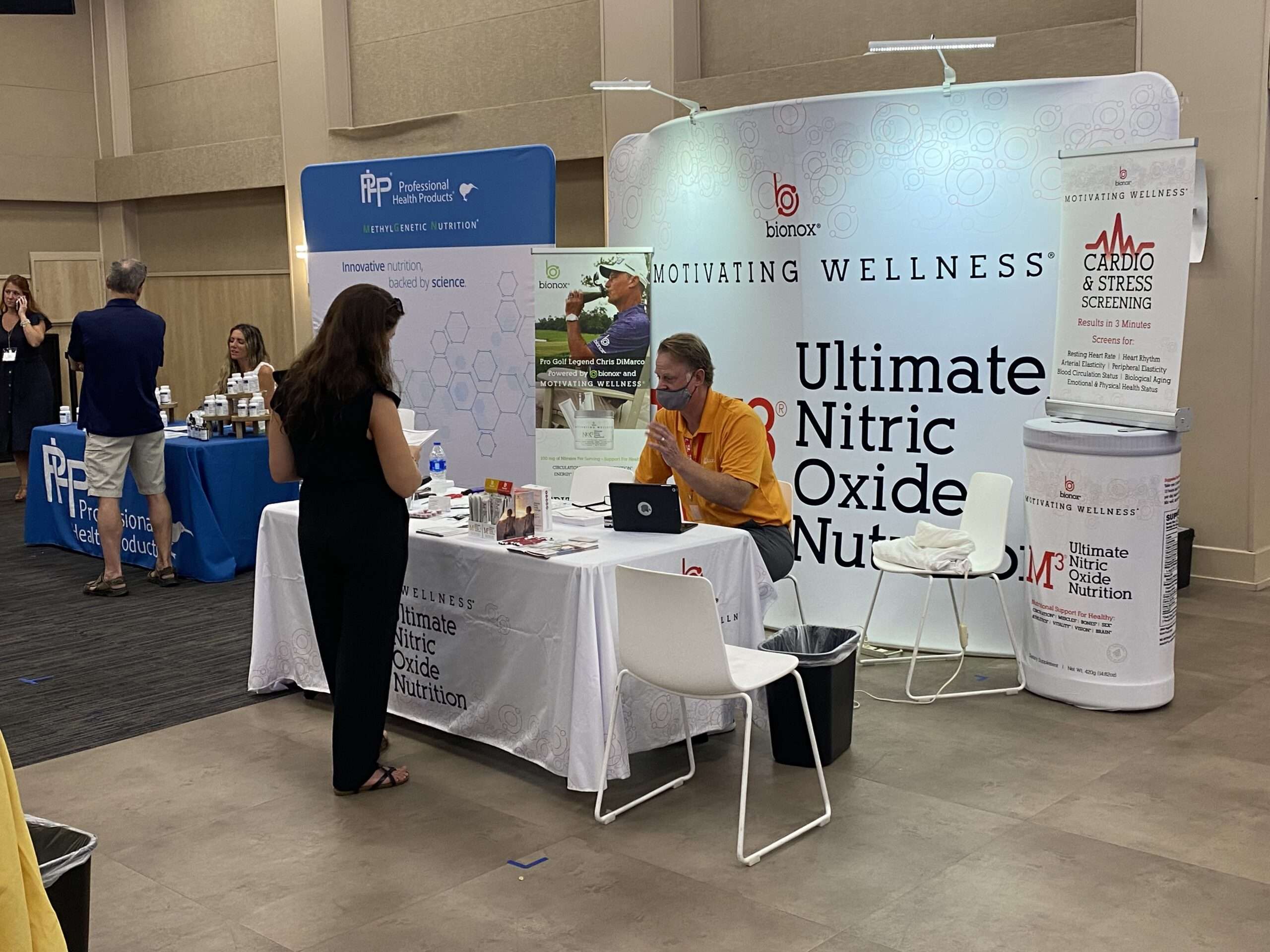
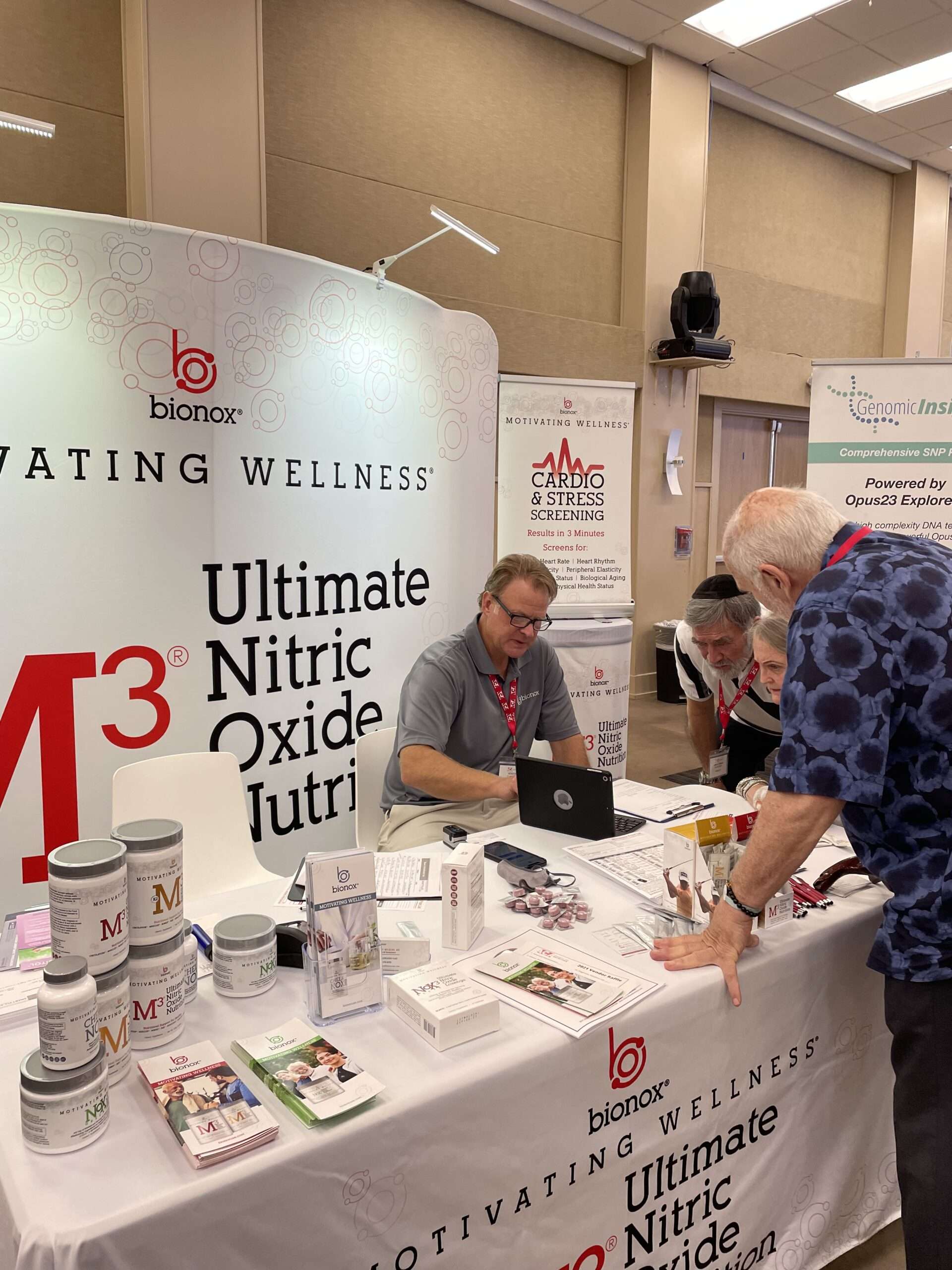
"It is always an inspiration to get out in public, finally, and talk with fellow colleagues. I enjoy learning about other doctors in the natural medical realm."
At the Bionox booth you can learn all about each of our products with free samples. We even have a cardio and stress screening that shows results in just 3 minutes. If you ever get the chance to join a conference with us there, we would love to see you!
Make sure you follow all our social platforms for any future conferences or speaking events:
Facebook: https://www.facebook.com/bionoxnutrients
Instagram: https://www.instagram.com/bionoxusa/
Twitter: https://twitter.com/BioNoxNutrients
What is Nitric Oxide and Where Can I Find It?
What is Nitric Oxide?
Nitric oxide (NO) is a signaling molecule. A signaling molecule is responsible for transmitting information between cells in your body. NO is formed from the amino acid, l-arginine. Amino acid is necessary for the body to make proteins. Nitric oxide is a proven regulator in the vascular, immune, and nervous systems. There are two different pathways for nitric oxide; l-arginine, and nitrate pathway.
L-Arginine Pathway
Arginine is a precursor of nitric oxide. When combined with l-citrulline found in our best selling product, M3 Ultimate Nitric Oxide Nutrition, the benefits are optimal. Once consumed nitric oxide is produced from those amino acids.
Nitrate Pathway
Nitrates can be found in a variety of different superfoods such as beets, arugula, rhubarb, and watermelon. Once consumed the nitrates convert to nitric oxide in the body. This can be assisted in the new, and recently reformulated Nox3 Greens Ultimate Nitric Oxide Superfood, made with 26 powerful superfoods, and Nox3 Beets Ultimate Nitric Oxide Lozenge.
Nitric Oxide Benefits
In simple terms, nitric oxide relaxes your inner muscles of your blood vessels, causing them to widen, increasing blood flow, and lowering blood pressure. Thus, proving to be a regulator in the vascular system. In the immune system, NO is secreted to fight bacteria and parasites. Regarding the nervous system, nitric oxide works as a neurotransmitter to control functions ranging from digestion, blood flow, memory, and vision.
Nitric oxide prevents heart disease, increases stamina, decreases muscle soreness, and boosts exercise performance. Benefits found in our top products include; circulatory wellness, cellular energy, nitric oxide production, muscle and bone recovery, athletic performance, vitality, vision, brain function, digestion, and energy.

Foods that Naturally Increase Nitric Oxide
Nitric oxide can be increased naturally through either nitrates or amino acids from the foods listed below. Both can be assisted through nitric oxide supplements. All of which can be found on www.bionoxusa.com.
- Beets (found in Nox3 Beets Ultimate Nitric Oxide Lozenge)
- Garlic
- Watermelon (found in M3 Ultimate Nitric Oxide Nutrition)
- Dark Chocolate
- Leafy Greens
- Arugula (found in Nox3 Greens Ultimate Nitric Oxide Superfood)
- Spinach
- Citrus Fruits
- Pomegranate
- Nuts and Seeds
- Red Wine




